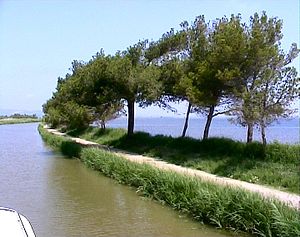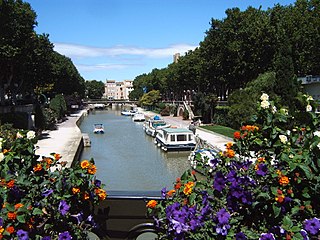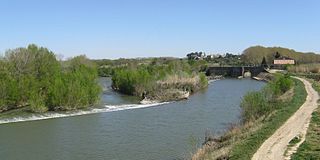Canal de la Robine
| Canal de la Robine | |
|---|---|
|
The Canal de la Robine in Narbonne |
|
| Water code | FR : Y --- 2002 |
| location | France , Occitania region |
| length | 33 km |
| Built | in ancient times |
| Expanded | 1686 |
| class | I ( Freycinet class ) |
| Beginning | Branch from the Aude river at Moussoulens |
| The End | It flows into the Mediterranean at Port-la-Nouvelle |
| Descent structures | 6th |
| Ports | Narbonne , Port-la-Nouvelle |
| Outstanding structures | Pont des Marchands |
| Kilometrage | Direction to the sea |
| The canal at the connection to the river Aude. The canal has its first lock (Moussoulens lock) behind the wall protecting against the Aude flood with a lockable gate. | |


The Canal de la Robine is a shipping canal located in France , in the Aude department in the Occitania region .
Course and technical infrastructure
It is a sea channel that runs from Moussoulens ( Moussan municipality ), on the Aude , to Port-la-Nouvelle , where it flows into the Mediterranean after 33 kilometers . The difference in height between the Aude valley and the mouth of the sea is only around nine meters, but six locks were built to overcome it . Between Narbonne and the estuary, the canal runs through a flat lagoon landscape ( Étang de Bages et de Sigean , Étang de l'Ayrolles ). The canal is supplied with water by the Aude River.
To the north, after about 650 meters of navigation on the Aude, the canal is continued in the Canal de Jonction , which connects to the Canal du Midi, which is only five kilometers away .
Coordinates
- Starting point of the canal: 43 ° 14 '42 " N , 2 ° 57' 39" E
- End point of the canal: 43 ° 1 ′ 30 ″ N , 3 ° 2 ′ 31 ″ E
Places on the canal
- Moussoulens , Moussan parish
- Narbonne
- Port-la-Nouvelle
history
Already in Roman times , the governor Agrippa had a canal dug through the ancient Rubrensis to connect the city of Narbonne with the Mediterranean. Thanks to this large canal - 30 m wide and 3 m deep - Narbonne became a rich coastal city. In the 14th century, however, the river Aude, which was responsible for the water supply of the canal, suddenly changed its course and no longer flowed through Narbonne. As a result, the city became impoverished and lost more and more of its importance. Finally, the city extended its dry canal to Moussoulens, where a water connection to the Aude could be re-established.
In 1787, the Canal de Jonction was built to establish a navigable connection with the Canal du Midi , which was built around 100 years earlier .
Economical meaning
The cargo shipping has gradually lost importance. Today the canal is mainly used by pleasure boats and houseboats .
Attractions
- Pont des Marchands in Narbonne, a bridge of houses of Roman origin
Web links
literature
- Voies Navigables, Canaux du Midi , 1998, Editions Grafocarte Verlag ISBN 2-7416-0054-6
Individual evidence
- ↑ a b The information on the canal length is based on the information on the Canal de la Robine from SANDRE (French), accessed on November 10, 2011, rounded to the nearest kilometer.

